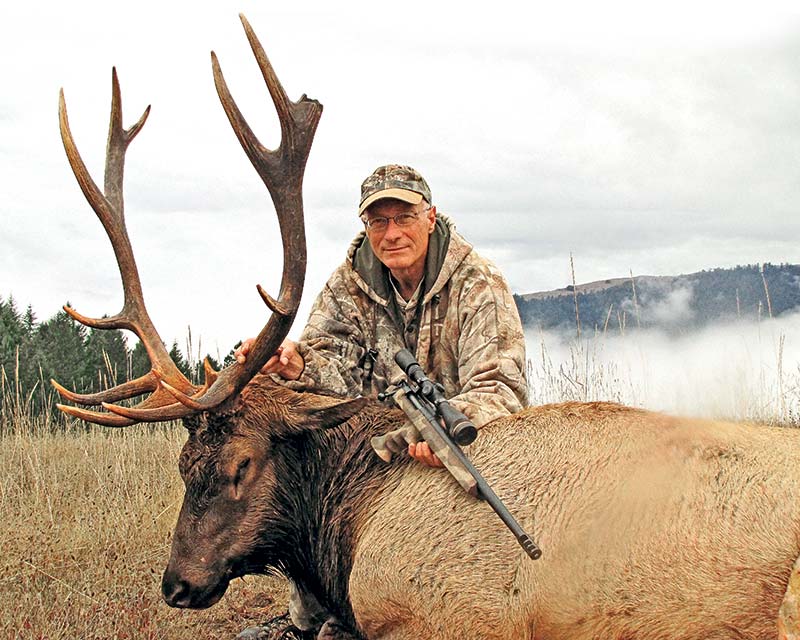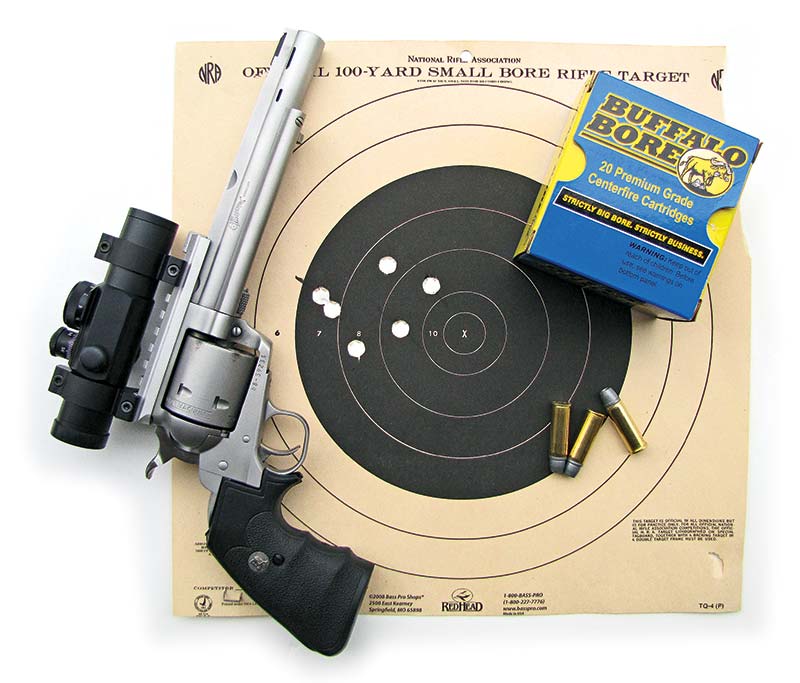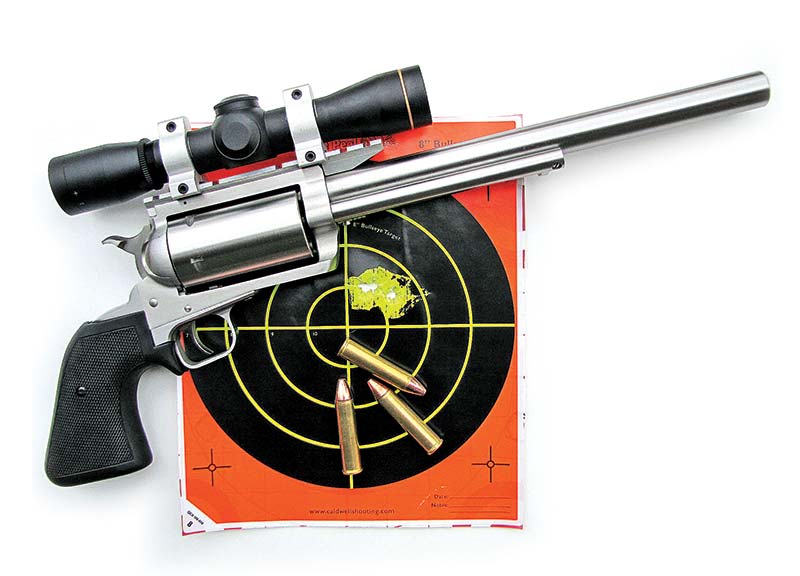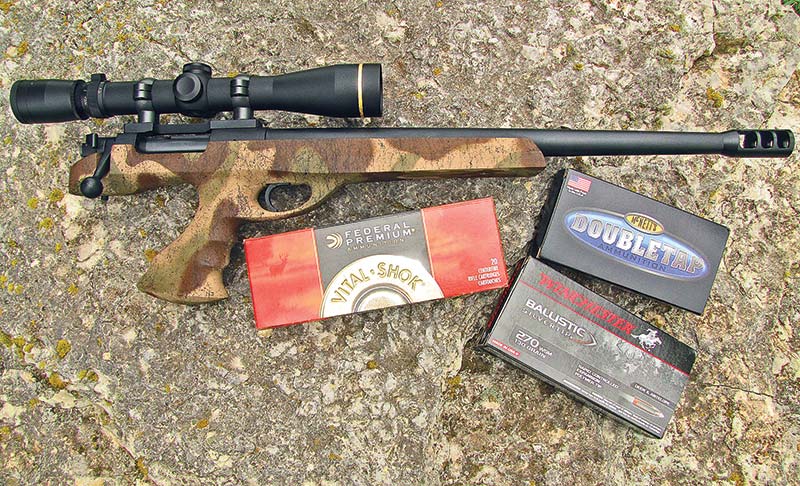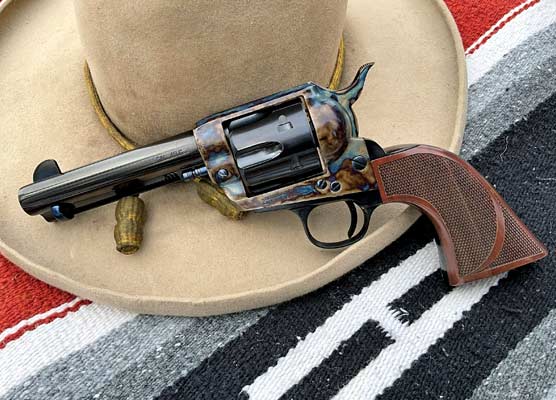Handgun Hunting: Really Large Critters
When The Quarry Is 1,000 Pounds… What Then?
During past issues we’ve chatted about handgun hunting strategies for varmints and medium-sized game. There are a boatload of efficient cartridges perfectly capable of handling varmints and whitetail deer. When you step up a notch and tackle really large animals like elk and moose here in North America, our selection of effective rounds is narrow by comparison and equally as critical. When you hunt big-bodied game like our moose and even some of the larger African antelope, matching the appropriate cartridge to the task can be challenging and fun.
These large game animals may weigh over 1,000 pounds in some cases. They have large, stout muscle groups and heavy bone structure. Choosing the right cartridge will insure a humane demise and freezer full of meat.
Revolvers
Revolver cartridges for really big game begin with the .44 Magnum. I consider this iconic caliber (with well-constructed bullets) the starting point for a revolver cartridge whenever elk or moose is concerned. The .45 Colt is another effective round when loaded properly. Likewise cartridges such as the .454 Casull, .475 Linebaugh, .460 S&W and .500 S&W Magnum all provide the necessary horsepower for elk hunting. Other similar big bore cartridges fill the bill too.
Bullet choice is another important consideration. I lean toward heavy-for-caliber bullets in these revolver cartridges, ensuring adequate penetration. Ideally, you want the bullet to penetrate through considerable mass, large bones, possibly heavy shoulder blades, and reach or better yet, pass through the vital heart and lung area. Expansion is not overly important, as the large .45- or .50-caliber bullets are making big holes when they enter. The most critical part is making sure the bullet reaches the vitals. If everything goes well an exit hole will provide two holes, resulting in additional blood loss, an easier trail to follow if necessary and an expeditious expiration.
There are a few top-notch revolvers making excellent hunting rigs. Choosing between single-action or double-action is largely a personal choice. Most hunting situations lend itself to shooting in single-action mode. Perhaps the biggest difference lies in grip configuration. Some prefer the plow handle design of single-actions. Others gravitate toward double-action frames. Choose whatever you shoot best.
Makers
Freedom Arms makes one of the finest revolvers on the market. Their single-action Model 83 is available in both Premium and Field Grade, chambered for some mighty effective elk hunting cartridges like the .454 Casull, .475 Linebaugh, and .500 Wyoming Express. These fine revolvers are available in several different barrel lengths.
Ruger offers their Super Redhawk and Super Blackhawk with a proven track record for ruggedness and dependability. The single-action Super Blackhawk comes in .44 Magnum. Ruger’s double-action Super Redhawk can be found in .44 Mag., .480 Ruger and .454 Casull.
Magnum Research provides their BFR, a large, single-action revolver capable of digesting several moose-clobbering cartridges including .45-70 and .450 Marlin.
Smith & Wesson appeals to handgun hunters with their large X-Frame double-action revolvers in .460 and .500 S&W Magnum, both sixguns designed specifically for handgun hunting. They offer several models in .44 Magnum (like the classic “Model 29” series of variations) also slated for hunting. All of the revolvers mentioned have proven themselves in the field on a wide variety of game animals.
Under many circumstances elk, moose or large African antelope are taken well within the effective range of revolvers. However, there are occasions where extended ranges are possible, perhaps even necessary in some situations. A 200-yard shot on a 5-day elk hunt may be the only opportunity you get. Single-shot handguns are used frequently on large game and offer handgun hunters a viable option. They can be chambered for a number of calibers and tend to be very accurate.
Single-Shots
There’ve been many elk taken with the .308 Winchester with a well-placed single-shot. I’ve taken several kudu — an African antelope often compared to our elk — using the .308, but always waited for the ideal shot. In single-shot handguns the .308 is about my starting point for big critters.
An array of bottleneck cartridges are used for large animals, including one of my all-time favorites; the .375 JDJ. I have an Encore in .375 JDJ which can take credit for my taxidermist driving a Mercedes. The Hornady 270-gr. Spire Point is about the only bullet I load for elk-sized game. This cartridge has been used successfully all over the world by many handgun hunters. Cor-Bon provides ammo in at least two different bullet weights, so “factory” ammo is available. Experience tells me CorBon makes some serious hunting ammunition.
The .375 JDJ has a proven track record beyond reproach. It has been my “go-to” handgun for large African antelope and never once failed me. I’ve also taken huge Alaskan-Yukon moose and Rocky Mountain elk with the .375 JDJ using Hornady’s 270-gr. SP.
Another great round for big stuff is the old faithful .45-70 Government. When properly loaded, you can rest assured it’s plenty capable of delivering the power required for the largest moose wandering around in Alaska. There are many other cartridges capable of filling an elk or moose tag.
The Handguns
Single-shot handguns come in a variety of styles. T/C’s Encore is a break-open design chambered for several big game cartridges. The MOA Maximum features an incredibly strong falling block action. It has the strength to launch just about any cartridge you desire. This unique single-shot is very accurate.
A few years ago Freedom Arms introduced their break-open single-shot Model 2008. It’s now available in .45-70 along with other calibers suited for the big boys, including .338 Federal and .454 Casull.
H-S Precision makes one of the finest bolt-action, single-shot pistols available. I’ve been hunting with one of these accurate handguns in .270 WSM. With a Holland muzzle brake installed, recoil is a non-issue. Recently I took a Roosevelt elk in northern California with this pistol. Nosler’s 140-gr. AccuBond did the trick. Just like revolvers, hunters should choose premium bullets. All the major bullet manufacturers like Nosler, Hornady, Sierra and Barnes for example, offer quality bullets specifically tailored for selected game.
With the proliferation of black rifles, the concealed-carry explosion and modern concealed carry pistol designs — and other tactical-type firearms — hunting handguns have taken a back seat. I understand the dynamics of business and economics. The small number of handgun hunters pales in comparison to the tactical market — whatever that is.
But makers need to take notice of something. Hunting in general, and handgun hunting plays a part of it, is growing strongly. “Shooters” are discovering hunting is something fun to do to “exercise” their love of handguns. Toward that end, I think handgun hunters in general would definitely welcome more options for the field. I wish Savage would re-introduce their Striker or Remington bring back the XP-100, for instance. Or what might a focused design team from, say, Ruger or S&W or Remington come up with that’s new?
Important Points
Handguns, revolver or single-shot, capable of bringing down a moose generate considerable recoil. Any optics involved will require quality mounts and rings installed securely. Now is not the time to skimp on optics. Scopes or red-dot sights must be able to withstand brisk recoil. In the past I have experienced excellent results from scopes like Leupold, Burris and Bushnell’s Elite 2-6X. Depending on the gun, caliber, terrain, hunting method and other variables, it may lead you to a fixed or variable power scope. The red-dot sight from UltraDot is another option. This optic can also endure bone-jarring recoil. It’s impossible to hit what you can’t see. Quality optics enhances your shooting, especially during those early morning or late evening opportunities.
Regardless of the type of handgun or how big the caliber might be, nothing trumps proper shot placement. There’s no substitute for a well-placed shot. As ethical and responsible hunters, we owe it to the magnificent game we pursue to ensure a quick, humane death. This should be a priority for all of us.
To help achieve this goal, every possible aid to steady the crosshair needs to be considered. Experienced handgun hunters are innovative. They will use whatever they can find to get a good, solid rest. This may come in the form of a backpack, shooting sticks, tripod or whatever else is beneficial, including a handy rock or limb.
It’s actually very simple, so don’t overthink it. A well-placed bullet, in the proper caliber will provide a freezer full of venison — and a punched tag. Not to mention a happy hunter.
Tackling really large game with a handgun is challenging. But it’s not an impossible undertaking. With the right equipment and preparation, filling your moose or elk tag will be memorable and rewarding. Cherish the journey.

